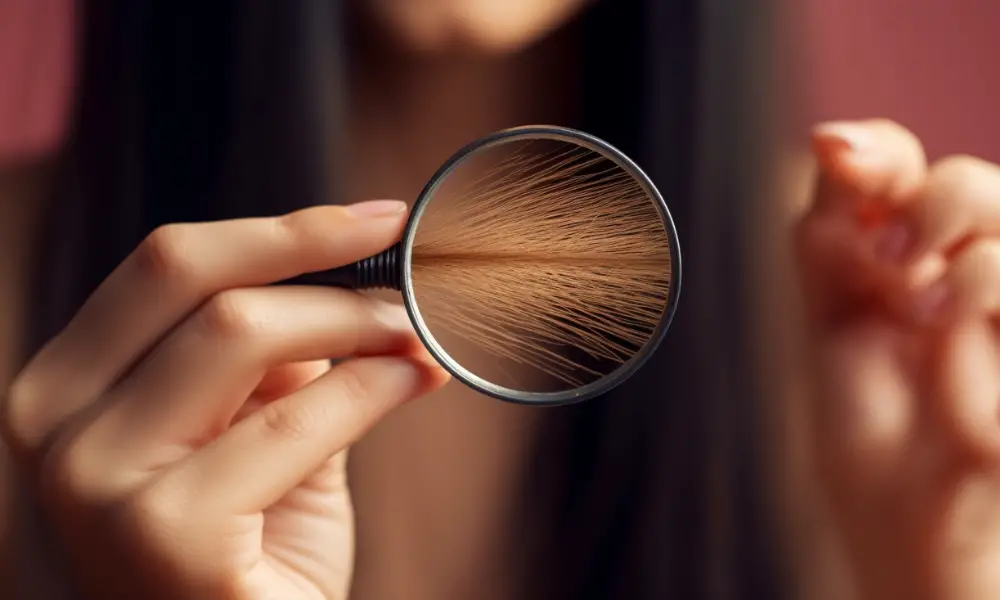Does Low Porosity Hair Need Protein?
If you have low porosity hair, you may already be familiar with the challenges of caring for it. Due to its tightly packed cuticles, low porosity hair can be resistant to moisture and product absorption.
However, one question that often arises is whether or not protein treatments are necessary for this type of hair. The answer isn’t straightforward.
While protein can help strengthen the hair shaft and improve elasticity, too much protein can actually harm low porosity hair by causing it to become brittle and prone to breakage. So how do you know when your low porosity hair needs protein?
In this article, we’ll explore the causes and characteristics of low porosity hair, common problems associated with this type of hair, effective products for managing it, and tips for healthy care practices. By understanding the unique needs of your low porosity locks, you’ll be better equipped to care for them properly – without risking damage from unnecessary protein treatments.
Key Takeaways
– Low porosity hair already contains a lot of natural protein called Keratin, so additional protein is not necessary and can make hair feel brittle and hard.
– Protein-rich products can cause dryness, tangles, and brittleness in low-porosity hair, so they should be avoided.
– Moisture retention is key for low-porosity hair, so using clarifying and water-based products and avoiding heavy products and silicones can help.
– The LOC method, involving using a liquid, oil, and cream to seal in moisture, is better than the LCO method for low-porosity hair.
Causes and Characteristics of Low Porosity Hair
So, if you have low porosity hair, you might be wondering if it needs protein treatments to stay healthy and strong.
Low porosity hair has tightly packed cuticles that make it difficult for moisture to penetrate naturally. As a result, low porosity hair tends to be dry and prone to frizz, which can lead to breakage and split ends.
Characteristics of low porosity hair include resistance to water and chemical treatments, accumulation of products outside the shaft, and dryness at the ends.
While some people with low porosity hair may also have protein sensitivity, others may benefit from regular protein treatments. This is because hair needs a balance of both moisture and protein in order to maintain its strength and elasticity.
However, it’s important to note that too much protein can actually make low porosity hair feel brittle and hard. For this reason, it’s recommended that those with low porosity hair avoid heavy products containing proteins such as keratin or collagen.
Instead, opt for lightweight products that provide adequate moisture retention without weighing down the strands.
Common Problems With Low Porosity Hair
Struggling with dry, brittle hair that just won’t grow no matter what you do? It’s time to take a closer look at your protein intake. While it’s true that protein is essential for healthy hair growth, low porosity hair requires careful consideration when it comes to protein in your hair care routine.
Here are some common problems associated with low porosity hair and its relationship with protein:
- Protein overload: Low porosity hair has tightly packed cuticles that make it difficult for moisture to penetrate the shaft. This means that applying too much protein can lead to an overload of hard, brittle strands that break easily. If you notice your hair feeling stiff or straw-like after using a product with high levels of protein, it may be time to switch things up.
- Lack of elasticity: One of the hallmarks of healthy hair is its ability to stretch and return back to its original shape without breaking. However, low porosity hair often lacks this elasticity due to the tightly closed cuticles that prevent moisture from entering the strand. Adding too much protein can exacerbate this issue by making the strands even more inflexible.
- Difficulty retaining moisture: As mentioned earlier, low porosity hair struggles with moisture retention due to its closed cuticles. While protein is important for strengthening the strand, without adequate hydration from water and other moisturizing agents, all those proteins will go to waste.
To avoid these common problems associated with low porosity hair and protein use, it’s important to strike a balance between strength and hydration in your hair care routine. Incorporating regular deep conditioning treatments using heat or steam can help lift those stubborn cuticles and allow essential moisture in while still providing the necessary proteins for strong, healthy locks. Additionally, opting for lightweight products free of heavy oils and silicones can also aid in maintaining moisture retention without overloading on proteins that could ultimately do more harm than good in the long run.
Effective Products For Dealing With Low Porosity Hair
Achieving healthy, moisturized locks is possible with the right products tailored to your low porosity hair. When it comes to protein, it’s important to understand that while low porosity hair carries a lot of its own natural protein called Keratin, too much additional protein can make your hair feel brittle and hard.
So, do you need protein in your hair care routine? The answer is that it depends on your individual needs and preferences. If you do decide to incorporate protein into your low porosity hair care routine, there are effective products available on the market.
Protein conditioners like Shea Moisture Manuka Honey & Yogurt Hydrate + Repair Protein Power Treatment or Mielle Organics Babassu Oil & Mint Deep Conditioner can help strengthen and repair damaged strands without causing further dryness or breakage. It’s important to note that these types of conditioners should only be used once every four to six weeks as overuse can lead to adverse effects.
In addition to using protein conditioners sparingly, other effective products for low porosity hair include lightweight oils like almond and argan oil for sealing in moisture and avoiding buildup. Water-based leave-in conditioners such as Kinky-Curly Knot Today or Giovanni Hair Care Direct Leave-In Weightless Moisture Conditioner also work well for retaining moisture without weighing down your strands.
Remember, finding the right combination of effective hair care products is key to achieving healthy and moisturized low porosity locks.
Low Porosity Hair Care Tips
To keep your low porosity locks healthy and moisturized, try incorporating these hair care tips into your routine.
First, focus on moisture treatments to ensure that your hair is hydrated and strong. Use natural ingredients like aloe vera gel or juice to help seal in moisture after washing or deep conditioning. Consider using lightweight oils such as argan oil or sweet almond oil to avoid buildup and nourish the hair.
Second, choose products that are specifically formulated for low porosity hair. Avoid protein-rich products as they can make the hair feel brittle and hard. Instead, opt for clarifying shampoos and water-based conditioners with humectants that aid in moisture retention. Look for leave-in conditioners that can help retain moisture throughout the day without weighing down the hair.
Incorporate regular deep conditioning treatments with heat to open up the cuticle layer and allow for better product absorption. Consider steaming your hair at home with a portable steamer or using the greenhouse effect method by covering your head with a plastic cap after applying conditioner.
With these tips, you can maintain healthy and moisturized low porosity locks without worrying about dryness or buildup.
Related Concepts
Discover the benefits of incorporating avocado into your natural hair routine to keep your locks healthy and moisturized. Avocado is a natural moisturizer for hair, making it a great addition to any low porosity hair care regimen.
Low porosity hair has tightly closed cuticles that make it difficult for moisture to penetrate, but avocado’s good fats can help nourish and hydrate the hair strands.
When it comes to protein balance in low porosity hair, it’s important not to overdo it. While protein treatments can strengthen the hair, too much protein can lead to dryness and breakage. Instead, focus on using lightweight products that won’t weigh down your hair or leave buildup on your scalp.
Look for water-based products with ingredients like aloe vera gel or juice that can help seal in moisture without adding extra weight.
Incorporating these tips into your low porosity hair care routine can lead to healthier, more manageable locks. By understanding the unique needs of low porosity hair and using products that work well with its texture and structure, you’ll be able to achieve the perfect balance of moisture and strength for beautiful, shiny tresses. So why not give avocado a try? Your curls will thank you!
Frequently Asked Questions
Can low porosity hair be transformed into high porosity hair with proper care and treatment?
No, low porosity hair cannot be transformed into high porosity hair with proper care and treatment. Hair porosity is determined by genetics, and while care can improve its condition, it cannot change its inherent level of porosity.
Is it possible for low porosity hair to become more porous over time due to environmental factors?
It is not possible for low porosity hair to become more porous over time due to environmental factors. Hair porosity is determined by the structure of the hair cuticle and cannot be changed by external influences.
How often should low porosity hair be trimmed to prevent split ends?
To prevent split ends, low porosity hair should be trimmed every 8-12 weeks. Regular trims help remove damaged ends and promote healthy hair growth. However, individual factors such as heat styling and chemical treatments may require more frequent trims.
Are there any specific vitamins or supplements that can improve low porosity hair health?
There is no specific vitamin or supplement that has been proven to directly improve low porosity hair health. However, maintaining a healthy diet and staying hydrated can benefit overall hair health. Consult with a healthcare professional for personalized recommendations.
Can low porosity hair benefit from using a hair mask or hot oil treatment?
Yes, low porosity hair can benefit from using a hair mask or hot oil treatment. These treatments help to moisturize and nourish the hair shaft, improving its overall health and appearance. It is recommended to use heat when applying these treatments for better absorption.
Conclusion
In conclusion, low porosity hair requires a unique approach to care for its tightly packed cuticles that make it resistant to moisture and product absorption. While protein treatments aren’t necessarily harmful, they may not be necessary for this hair type. It’s important to focus on providing adequate moisture and hydration through the use of water-based products and avoiding heavy oils or butters that can weigh down the hair.
Effective products for low porosity hair include lightweight leave-in conditioners, humectants such as glycerin or aloe vera, and clarifying shampoos to remove buildup. Additionally, incorporating steam treatments or using a hooded dryer can help open up the cuticles for better product absorption.
Overall, understanding the unique characteristics of low porosity hair and tailoring your hair care routine accordingly can lead to healthy, strong, and moisturized locks. By prioritizing hydration over protein treatments and using effective products tailored to your specific needs, you can achieve optimal results for your low porosity hair.


